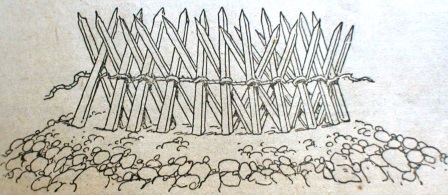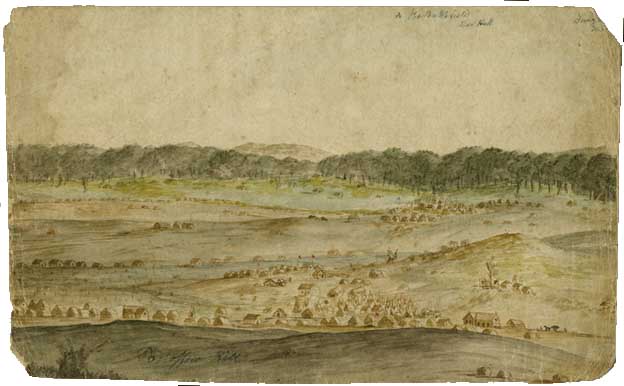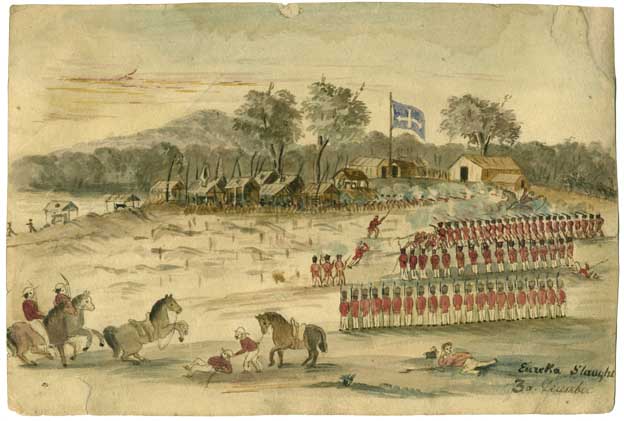Difference between revisions of "Eureka Stockade"
Dottigee16 (talk | contribs) (→Independent California Rangers) |
|||
| Line 55: | Line 55: | ||
[[--- Smith]] | [[--- Smith]] | ||
| + | |||
| + | |||
| + | == In the News == | ||
| + | |||
| + | :NOTICE.-Government Camp, Ballarat. | ||
| + | :December 3, 1854 | ||
| + | :Her Majesty's forces were this, morning fired upon by a large number of evil disposed persons of various nations, who had entrenched themselves in a stockade on the Eureka, and some officers and men killed or wounded. | ||
| + | :Several of the rioters have paid the penalty of their crimes, and a large number are in custody. | ||
| + | :All well-disposed persons are earnestly requested to return to their ordi nary occupations, and to abstain from assembling in large groups, and every protection will be afforded to them by the authorities. | ||
| + | :ROBT REDE | ||
| + | :Resident Commissioner. GOD SAVE THE QUEEN! <ref>''Adelaide Advertiser'', 3 December 1904.</ref> | ||
| + | |||
| + | |||
== Also See == | == Also See == | ||
Revision as of 11:30, 15 August 2013
Contents
Overview
The stockade at Eureka was built on 30 November 1854, and was destroyed during the Eureka Battle on 03 December 1854.
- The most harrowing and heartrending scenes amongst the women and children I have witnessed through this dreadful morning. Many innocent persons have suffered, and many are prisoners who were there at the time of the skirmish but took no active part [...] At present every one is as if stunned, and but few are seen to be about. The flag of the diggings, "the Southern Cross," as well as the "Union Jack," which they had to hoist underneath, were captured by the foot police.[1]
- The stockade, a rough barricade, enclosing about an acre of ground, on the Eureka lead, behind where the Orphan Asylum now stands, was made Lalor's headquarters. The barricade was a flimsy affair, constructed of slabs stuck on end, brush wood, and whatever could be obtained handy. It enclosed several tents, stores, and windlass claims, and appears to have been designed to conceal the operations of the head quarters staff rather than as a fort, in spite of Lalor's untiring efforts it it was difficult to enforce discipline. Men came and went freely, and all that happened was known to the commissioner. The diggers knew that another large reinforcement of troops from Melbourne was expected, and they believed they were secure until these arrived.
- Captain Thomas, the officer in command of the military forces at the camp, realising that the diggers had been lulled into a false sense of security resolved on a surprise attack. On Sunday morning, December 3rd, just before daybreak, he led out his men (276) and stole silently to the gully between Cattle Yard Hill and the hill which Rodier-street now bisects, and wheeled round on the stockade, near the Free Trade Hotel, which was kept by Lester (afterwards of Lester's Hotel Sturt street). It was bright moonlight, and just breaking dawn Lalor's pickets sighted the red coats, and fired, and were answered by a volley from the troops. It is generally agreed there were not more than 300 men in the stockade at the time. Many of these were asleep. Numbers had only the clumsy pikes for arms. A few volleys and then the charge, and tee barricade fell like a pack of cards, and the fight was over in 25 or 30 minutes from the time the first shot was fired.
- Fourteen of the diggers were killed outright, or subsequently died of their wounds, and 12 others were wounded, and a great batch of prisoners were taken. Lalor had his left arm smashed with a bullet. He was hidden under a pile of slabs, and escaped. Some days later his arm was amputated, and he was conveyed to Geelong, and kept in hiding until a general pardon was granted to those who had taken part in the episode. Two hundred pounds reward was offered for Lalor and the same amount for Black, and £500 for Vern who was concealed for week's in a diggers tent near Eureka. The loyalty of the digger's was such that none of the leaders were betrayed.
- Captain Wise, second in command of the soldiers, was killed by one of the first shots fired from the stockade. Three privates were also killed, while several were badly wounded, one subsequently dying. The diggers were buried in one grave in the old Ballarat Cemetery, and a monument, presented by Mr. James Leggatt, of Geelong, erected over it in 1836. The soldiers were buried in the same cemetery close by, and the Victorian Government erected a monument to mark their grave in 1879.[2]
Pikemen
- ...Raphaello made a speech. He said— "Gentlemen soldiers, those that cannot provide themselves with firearms, let them provide themselves with a piece of steel, if it is only six inches long, attached to a pole, and that will pierce the tyrant's heart." He marched his men to Eureka, and drilled them there on that and the following day. ...[3]
- Drilling proceeded vigorously. Blacksmiths hammered away at pikes - rude weapons like a billhook fastened on the end of stringy-bark saplings. The stockade, a rough barricade, enclosing about an acre of ground, on the Eureka lead, behind where the Orphan Asylum now stands, was made Lalor's headquarters. The barricade was a flimsy affair, constructed of slabs stuck on end, brush wood, and whatever could be obtained handy. It enclosed several tents, stores, and windlass claims, and appears to have been designed to conceal the operations of the head quarters staff rather than as a fort, in spite of Lalor's untiring efforts it it was difficult to enforce discipline. Men came and went freely, and all that happened was known to the commissioner. The diggers knew that another large reinforcement of troops from Melbourne was expected, and they believed they were secure until these arrived. [4]
The following were known to be Pikemen at Eureka: Bryant; William Emmermann; John Joseph; John Manning[5]; Edward Thonen;
Pikeman's Dog
The RSPCA Purple Cross Award was presented to the Pikeman's Dog posthumously at the Ballarat Fine Art Gallery on 30 November 1997. The ceremony took place in front of the original Eureka Flag that the Pikeman died defending at Eureka Stockade in 1854. Detective Sergeant Peter Lalor, the great-great-grandson of Peter Lalor the leader of the diggers at Eureka Stockade accepted the award on behalf of the Eureka trust.[6]
The Pikeman's Dog, a little terrier, showed great devotion and bravery at the death of his master at the Eureka Stockade on 3 December 1854. As a result of the attack on the miners by Crown forces, five British soldiers and some thirty miners died. Among the miners lay a Pikeman, mortally wounded with some 15 wounds. Guarding his body throughout the hours it lay unclaimed at the battlefield, and later accompanying it on the death cart as the remaining bodies were transferred to the cemetery, was this little companion. This was the Pikeman's Dog.[7]
The RSPCA Australia Purple Cross Award recognises the deeds of animals that have shown outstanding service to humans, particularly if they showed exceptional courage in risking their own safety or life to save a person from injury or death.[8]
The Award was named to honour the Purple Cross Society which was established soon after the outbreak of World War I to raise funds for the supply of gear and veterinary treatment for the Light Horse Brigade. The Purple Cross Society was disbanded in 1971 and the RSPCA in Victoria was charged with preserving and displaying the flag of the Society, which now hangs in the Council Room of the RSPCA Victoria headquarters. As a tribute to the memory of all of Australia's war horses, the RSPCA Australia exceptional animal award is known as the Purple Cross Award. Recipients of the Purple Cross Award receive a Purple Cross medal and a certificate.[9]
An unpublished diary makes reference to William Emmermann as the pikeman whose terrior would not leave his side after Emmerman’s death, although according to Peter Lalor the pikeman could have been Edward Thonen.
Independent California Rangers
In the News
- NOTICE.-Government Camp, Ballarat.
- December 3, 1854
- Her Majesty's forces were this, morning fired upon by a large number of evil disposed persons of various nations, who had entrenched themselves in a stockade on the Eureka, and some officers and men killed or wounded.
- Several of the rioters have paid the penalty of their crimes, and a large number are in custody.
- All well-disposed persons are earnestly requested to return to their ordi nary occupations, and to abstain from assembling in large groups, and every protection will be afforded to them by the authorities.
- ROBT REDE
- Resident Commissioner. GOD SAVE THE QUEEN! [10]
Also See
References
- ↑ The Argus, 19 December 1854.
- ↑ Charleville Times, 31 December 1904
- ↑ The Argus, 11 December 1854.
- ↑ Charleville Times, 31 December 1904
- ↑ The Argus, 11 December 1854.
- ↑ http://www.rspca.org.au/what-we-do/awards/rspca-purple-cross-award.html, viewed 12 May 2013.
- ↑ http://www.rspca.org.au/what-we-do/awards/rspca-purple-cross-award.html, viewed 12 May 2013.
- ↑ http://www.rspca.org.au/what-we-do/awards/rspca-purple-cross-award.html, viewed 12 May 2013.
- ↑ http://www.rspca.org.au/what-we-do/awards/rspca-purple-cross-award.html, viewed 12 May 2013.
- ↑ Adelaide Advertiser, 3 December 1904.


